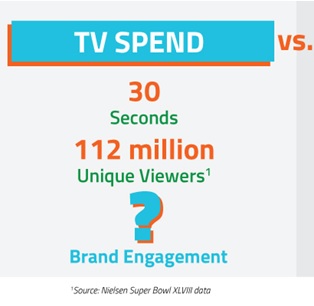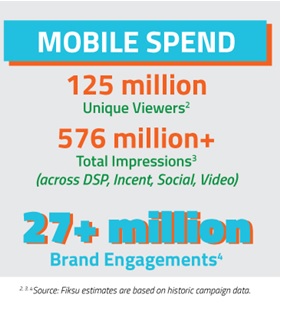Like you, many of us here at Jackson spent Sunday night tuned into the Mega Huge Sport Game-o-Rama* with an eye out for the most expensive ads of the year. Each of these ads was expected to reach roughly 110 million viewers in the US during the game at a price tag of $4.6 million to $5 million for a 30-second spot.
These viewers don’t skip past commercials with the help of a DVR. Nor do they step out of the room for a snack plate refill. For many, the ads are more important than the game itself, with advertisers hoping to parlay that spectacle into water-cooler commentary at work the next day. You and I know this as Word-Of-Mouth Marketing, or the voluntary, social reinforcement of popular brand messages between individuals.
So like us, you may be wondering: Do expensive ads mean big results?
Our take: Not without social media.
In terms of the ads alone, the statistics aren’t very encouraging. Data from Genesis Media suggests that 90% of people aren’t likely to purchase a product they saw during the game, and that 75% of people don’t remember ads from the previous year. Moreover, marketing research from Communicus suggests that only 20% of these commercials actually drive changes in brand purchases. That’s a serious gap between investment and return, and if you’re like us, there isn’t a spare $5 million lying around to gamble on those kinds of odds.
There is an emerging upside: these statistics shift when marketers factor social media into the budget.
To snapshot the audience, Salesforce conducted a poll of more than 400 consumers and found that nearly two-thirds of viewers would be using Facebook while watching the game, and that younger viewers would be most active and engaged on Twitter and Snapchat. Among these viewers, BrandAds finds that men are 13.3% more likely than women to purchase an advertised brand after the game, and consumers under the age of 18 are 37.1% more likely to be influenced into purchases; the most of any age demographic.
Keep that in mind as we go back to Communicus for another telling stat – nearly half of the game’s advertisers translate social or online viewing into purchases. That’s 30 percentage points higher than the broadcast ad alone.
So to translate the investment of one broadcast advertisement into social media engagement, we took a look at the data from Fiksu, a mobile marketer.

 For the same investment, advertisers stand to reach an audience that is five times larger than broadcast with the added bonus that people tend to share content they enjoy–for free. More importantly, online and social marketing enables consumers to act on an advertisement immediately, clicking through to a website, shopping an online store or otherwise extending their engagement with the brand. And so far in 2016, you can’t get all of that through a TV screen.
For the same investment, advertisers stand to reach an audience that is five times larger than broadcast with the added bonus that people tend to share content they enjoy–for free. More importantly, online and social marketing enables consumers to act on an advertisement immediately, clicking through to a website, shopping an online store or otherwise extending their engagement with the brand. And so far in 2016, you can’t get all of that through a TV screen.
The best part of social advertising is that the playing field is open to all. Social advertising is build around a cost-per-click (CPC) or a cost-per-thousand views (CPM), which means that brands can scale a campaign to fit specific needs and can adjust quickly around more immediate performance feedback.
So if you have the budget, Mega Huge Sport Game-o-Rama* is still an excellent way to reach a large, captive audience. But if your budget is lacking, get engaged with social and meet your customers where they’re already engaged.
*The jury’s still out on who can actually say S***r B**l without getting sued. We’re not taking any chances.








